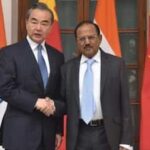Negotiators from the US and China are set to begin talks on Saturday in Geneva, potentially paving the way for a trade deal, after the US President stated that “80 per cent tariffs on China seem right” amid early signs of easing trade tensions between the world’s two largest economies.
This comes as trade tensions between the two countries had started benefiting India, as US buyers began turning to Indian suppliers following the imposition of 145 per cent tariffs by the US on Chinese goods. These tensions have also improved India’s prospects for deeper economic integration with Western nations.
However, a possible thaw in relations between the US and China could help Beijing regain lost ground, owing to its well-established technical capabilities — thereby reducing India’s chances of capitalising on this geo-strategic opportunity, particularly amid multiple ongoing trade deal negotiations.
Indian exporters said that several Chinese exporters have approached Indian suppliers for help in fulfilling US orders, as they seek to retain their American clients. A deal that results in lower tariffs on Chinese goods could weaken the role of Indian suppliers.
Notably, data from China’s Ministry of Commerce showed that while China’s exports to the US fell by over 20 per cent in April, its overall exports rose by 8.1 per cent year-on-year, buoyed by strong performance in the ASEAN region and other markets indicating limited impact of US tariffs.
A potential US–China trade deal could quickly help Chinese exporters recover, due to superior technical expertise China has built over the years. Indian manufacturers say the country is currently not equipped to meet US demand in several labour-intensive sectors, such as non-leather footwear.
Mecca Rafeeque Ahmed, past president of the Federation of Indian Export Organisations (FIEO), said that India’s footwear industry is still largely focused on leather, while US demand lies mainly in the non-leather segment where China remains dominant.
“A number of inquiries are coming in from the US, and India is shifting towards the non-leather segment. But a portion of the business may well move to Bangladesh, as the movement of Chinese professionals is not restricted there. Chinese technicians and machinery have helped boost productivity,” Ahmed said.
Notably, Vietnam has also emerged as a major footwear manufacturing hub, in part due to its deepening ties with China. After the first trade war, Vietnam swiftly became the top supplier for Nike. The country has also leveraged Chinese expertise in the textile sector, becoming a key player in the global apparel supply chain.
A US–China trade deal may not be in India’s interest, as emerging markets like India stand to gain from the disruption caused by the ongoing trade conflict.
Richard Baldwin, Professor of International Economics at IMD Business School, told this paper that sustained high tariffs on China would benefit large emerging markets. “China was a big competitor before, and it has now been hobbled,” he said. However, he pointed out that the now-deferred reciprocal tariffs did not cover pharmaceuticals and electronics — two sectors where India could have gained significantly.
“From a geo-economic perspective, anything that’s bad for China is good for India,” Baldwin added.
Baldwin also remarked that a near-term thaw in US–China relations is unlikely, due to a bipartisan consensus in the US that views China as a national security threat.
“Within the US, there are two major factions. The first is the national security establishment, which sees China as a strategic threat. That sentiment dominates both the White House and Congress and isn’t going away. The second is the economic camp, which believes China’s trade practices are hurting the US. That view now enjoys broad support. Biden hasn’t rolled back Trump’s tariffs, and even if someone like had been elected, we wouldn’t have seen them lifted — perhaps just slowed,” he said.
Baldwin reiterated that the US is not moving closer to China, noting that Beijing is now retaliating more forcefully than before. “During Trump’s first term, China was relatively restrained. But now they’re hitting back, which could lead to factory slowdowns and job losses in the US,” he added.








